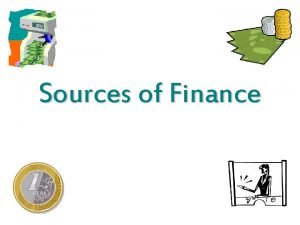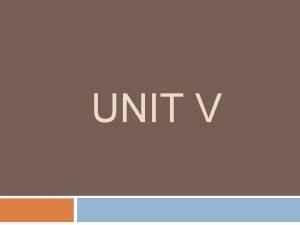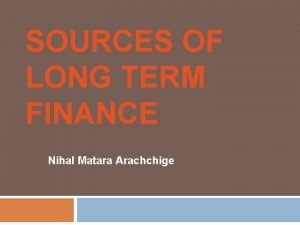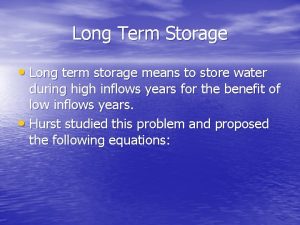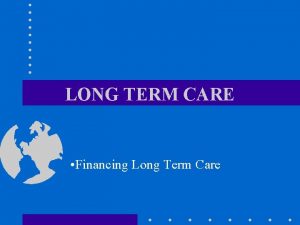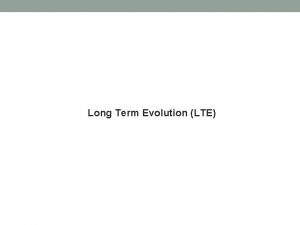Chapter 1 Long term Finance Sources of long














- Slides: 14

Chapter 1: Long term Finance Sources of long term finance v. Capital markets ( issue new shares, rights issue or issue of marketable securities) v. Bank borrowings v. Government and other similar sources IMAS 1

Equity finance Share – a fixed identifiable unit of capital in an entity which normally has a fixed nominal value. Ordinary shares – shares that pay a variable return at the director’s discretion. Preference shares – shares that pays a fixed dividend, which is paid before ordinary shares ( preference dividend are paid from post tax profits) IMAS 2

Preference shares v. Cumulative preference shares v. Non cumulative preference shares v. Participating preference shares v. Convertible preference shares IMAS 3

Capital markets Primary function v. Raise new finance Secondary function v. Liquidate investments IMAS 4

IPO Advantage v Accurate valuation v Liquidity v Raise profile ( usually results in an overall increase in value of the company) v Access to future investment v Employee share schemes more accessible Disadvantage v Costly for small entity v Reporting requirements are more onerous v Stock exchange rules for obtaining a quotation can be stringent IMAS 5

Tender offer & Placement Tender offer – alternative to a fixed price offer. Subscribers tender for the shares at, or above, a minimum fixed price. The prospective investor will then set a strike price and allocates shares to all bidders who have offered the strike price or more (all bidders will pay the strike price irrespective of what the original bid was) *** Dilution of existing shareholders should be kept at a minimum Placing – shares are placed directly with certain investors on a pre arranged basis. *** This method is quicker and cheaper IMAS 6

Rights issue New shares are offered for sale to existing shareholders, in proportion to the size of their shareholding Pre emption rights – right to buy new shares ahead of outside investors. ***Rights issue are cheaper to organise than a public share issue An issue price must be set which is: vlow enough to secure acceptance of shareholders, but vnot too low, so as to avoid excessive dilution of the earnings per share. IMAS 7

Market price after issue After the announcement of a rights issue there is a tendency for share prices to fall. The temporary fall is due to uncertainty about: vconsequences of the issue vfuture profits vfuture dividends After the actual issue the market price will normally fall again because: vthere are more shares in issue(adverse affect on earnings per share), and vnew shares were issued at market price discount. IMAS 8

Theoretical ex-rights price (N * cum Rights price) + issue price N + 1 IMAS 9

Implications of rights issue From the viewpoint of the shareholders: vthey have the option of buying shares at preferential price vthey have the option of withdrawing cash by selling their rights vthey are able to maintain their existing relative voting position (by exercising the rights). From the viewpoint of the company: vit is simple and cheap to implement vit is usually successful ('fully subscribed') v it often provides favourable publicity. IMAS 10

Debt Finance This is the loan of funds to a business without conferring ownership rights The key features of debt financing arising from this 'arm's length relationship ' are: v. Interest is paid out of pre tax profits as an expense of the business. v. It carries a risk of default if interest and principal payments are not me Security charges Fixed charge – debt is secured against specific assets Floating charge– debt is secured against general assets IMAS 11

Covenants v. Dividend restrictions v. Financial ratios v. Financial reports v. Issue of further debt Amount and types of debt that can be issued is restricted. Subordinated debt can usually still be issued IMAS 12

Forms of debt finance v. Money market borrowings v. Revolving credit facility – (borrower uses or withdraws money up to a pre approved credit limit) v. Bonds **A bond is a debt security, in which the issuer owes the holder a debt and, depending on the terms of the bond, is obliged to pay interest (the coupon) and/or to repay the principal at a later date. v. Commercial paper – is an unsecured short term loan issued by a corporation, typically for financing accounts receivables and inventories IMAS 13

Other sources of Finance Retained earnings Sale and leaseback Grants Debt with warrants attached Convertible debt Venture capital Business angel Government assistance IMAS 14
 Advantage of retained profit
Advantage of retained profit Long-term finance
Long-term finance Long term plan and short term plan
Long term plan and short term plan Long term memory vs short term memory
Long term memory vs short term memory Short term human resource planning
Short term human resource planning Difference between long term and short term liabilities
Difference between long term and short term liabilities Long term liabilities
Long term liabilities Long-term goals examples
Long-term goals examples Short-term financial management
Short-term financial management Print sources and web sources
Print sources and web sources Important water resources
Important water resources Sources of finances
Sources of finances Leaving cert business philip curry
Leaving cert business philip curry Why do businesses need finance
Why do businesses need finance Internal sources of finance
Internal sources of finance













